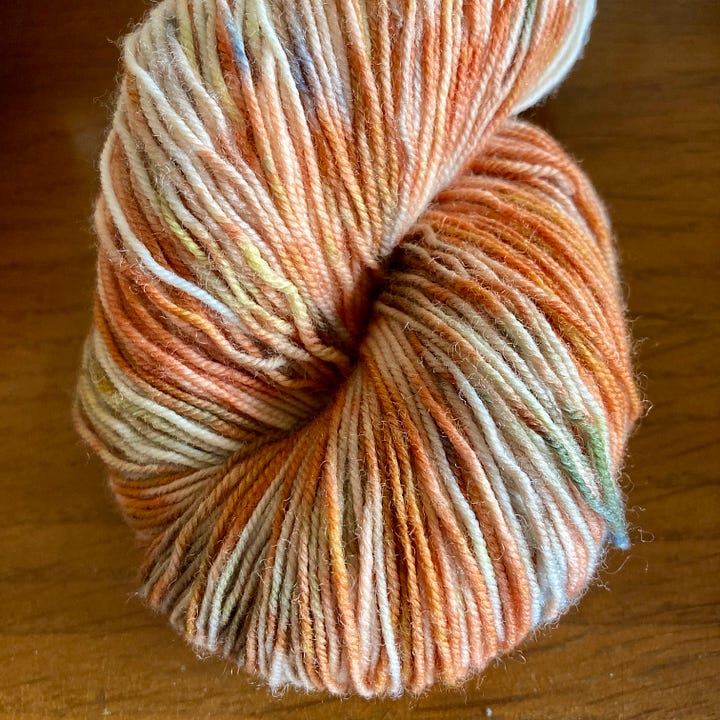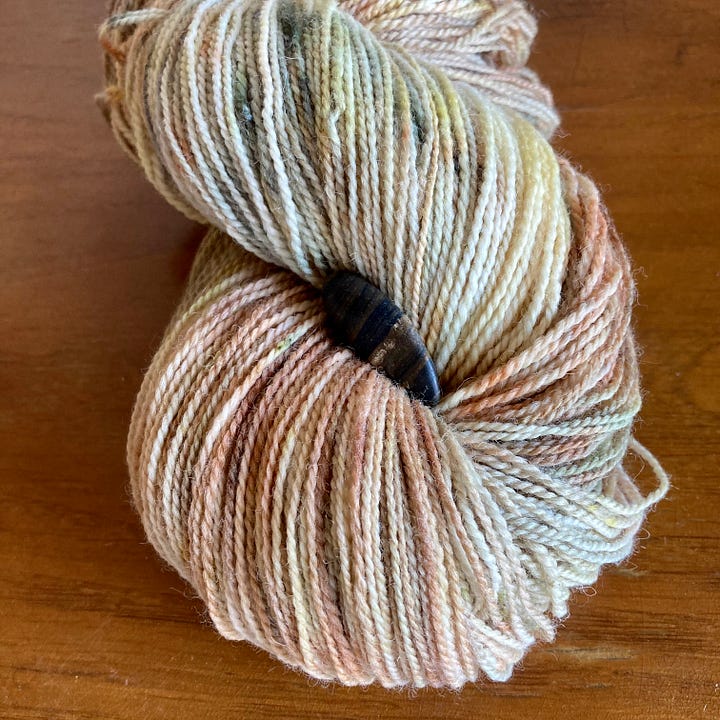This newsletter has English and Spanish versions. To choose which language you receive, visit your settings on Substack, find this newsletter under Subscriptions, and select the language(s) you want.
Leer en español aquí.
These socks I just finished are extra special because it’s the first time I’ve used a non-superwash sock yarn.
The conventional wisdom among sock knitters is that you should use a superwash yarn with some nylon blended in for elasticity. Superwash is an additional processing step for wool yarn that gets rid of the scales on the fiber so that the wool will resist felting and therefore machine washable. Socks do need to be washed frequently, so it’s nice to be able to throw them in the washing machine.
It’s also easy to see why dyers love superwash: because the scales of the yarn are removed during this treatment, it absorbs color much more readily than non-superwash yarns, making it an ideal base for the creative, saturated colorways many indie dyers are known for. Popular techniques like speckles are much easier to achieve on superwash yarn.


Unfortunately, superwash yarn does have downsides, especially when it comes to the overall environmental impact of the yarn. For one thing, the superwash process involves either chemically stripping the scales of the yarn or coating the wool with a polymer resin. Both of these processes involve the use of petrochemicals- that is, chemicals derived from fossil fuels. Petrochemicals are used to make plastics, which are both seemingly present in basically everything we use in modern life and causing horrifying environmental disasters that threaten human health and entire ecosystems. Although many of us recognize that we need to end the use of fossil fuels for transportation, production of petrochemicals is increasing, keeping us dependent on the same products that are destroying life on this planet. Textiles, in particular, the use of polyester and other synthetic fabrics has greatly increased in recent years. It might seem like we can’t eliminate plastic from our lives. I certainly haven’t, despite my efforts to cut down. But one area where I definitely don’t need the addition of plastic is in my wool yarn.
Another problem with the rise of synthetics in textiles is that they release microplastics in the wash, which end up in waterways and harm wildlife and human health . Handwashing reduces the amount of microplastics that are released- but if you’re going to hand wash your socks anyway, why not skip the plastic?
Finally, for me this question resonates on an emotional level, with the connection I feel with the materials I spend so much time with. Natural dyes are living color: they come from plants, they change over time, they can eventually biodegrade and return to the soil, participating in a regenerative cycle. Wool, too, feels alive to me - also a natural, biodegradable fiber with unique characteristics (elasticity, warmth, ability to repel water) that also make it incredible to wear and to knit with- and the superwashing process diminishes those characteristics (nylon is added to sock yarns to recover the elasticity that was lost during the superwash process). By minimizing the processing and use of harsh chemicals in the yarn I dye, I hope to create a living, durable and biodegradable product that can even be composted at the end of its life cycle.
I know that the decision to not use superwash wool is not going to save the planet all on its own. But that doesn’t mean it’s not important at all or not worth doing. For something as big as climate change, there is no one solution. It will take a lot of actions, both big and small. Avoiding the use of petrochemicals in my clothing, whether I make or buy it, is one of the actions that I can take.
Maybe that’s not true for everyone. I know people have their own reasons for using superwash. I haven’t completely eliminated the use of plastic from my life, so I know we’re all doing our best in a world that makes it hard to make sustainable choices. But when it comes to Neblina Wool, I have the chance to create a tiny amount of the kind of yarn I want to exist in the world- regenerative, biodegradable, and using natural, living color.
What to look for in a non-superwash sock yarn
I knit with Neblina Wool yarn a lot, but my current bases aren’t suitable for socks. I want a fingering weight that can be knit at a tight gauge (which increases durability), but my fingering base is 100% Merino. Merino is incredibly soft, making it a great choice for cowls and shawls, but isn’t really the best choice for socks, which need to be more durable. So, for a natural sock yarn, I look for other sheep breeds that are more hard-wearing. I also look for a yarn with a high twist: the more tightly a yarn is spun, the more strength it has. Some natural sock yarns use additional natural fibers that add strength to the yarn, like silk or mohair. The Wool & Palette yarn I used for the socks above is a high-twist blend of Merino and Rambouillet. The natural sock yarn I’m working with now, from Sunflower Knit, is a blend of wool and mohair.
Do you have a favorite all natural, non superwash sock yarn? Let me know in the comments!
News
I’m teaching my first workshop on March 25 at Espacio Raíz in Valparaíso. We’ll learn how to make unique naturally dyed speckled yarn. You can sign up by replying to this email or sending a message to neblina.wool at gmail. This workshop is also coming to Ohio in July, stay tuned for more info! Also, if you’re interested in this workshop in a different city or even online, send me a message and we can talk.
My yarns are all available on my website, which accepts credit card payments now!
You can always follow me on Instagram, Pinterest and the Making app.
Finally, if you enjoy reading this newsletter, please subscribe and share it with someone else who might like it!





